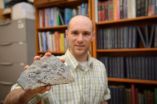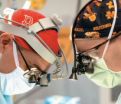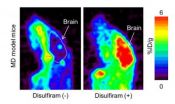(Press-News.org) Starting about 250 million years ago, at the end of the Permian period, brachiopod groups disappeared in large numbers, along with 90 percent of the planet's species. Today, only a few groups, or genera, of brachiopods remain. "Most people won't be familiar with brachiopods. They're pretty rare in the modern ocean," said Jonathan Payne, a paleobiologist at Stanford University.
Meanwhile, bivalves flourished, diversifying into a staggering variety of shapes and sizes, and spread from marine to freshwater habitats. "After the end-Permian mass extinction, we find far fewer brachiopods and a lot more bivalves," said Payne, who is an associate professor in the Department of Geological & Environmental Sciences.
Why one group of shelled animals thrived while the other barely survived is one of the great mysteries in paleontology. A popular theory, based on diversity and abundance data from the fossil record for the two groups, is that bivalves simply outcompeted brachiopods. But a new study by Payne and other researchers that looks at the issue from an energy standpoint paints a different picture. Their findings, published online on March 26 in the journal Proceedings of the Royal Society B, show that, despite being fewer in number, ancient bivalves were already consuming as much food as brachiopods, and that modern bivalves consume vastly more.
"Brachiopods and bivalves used about same amount of food during Paleozoic, but bivalve food intake has increased by a factor of 100 since then," Payne said. "There's no way that increase is the result of bivalves simply displacing brachiopods. Even if bivalves had entirely supplanted brachiopods, their metabolism would have only doubled."
Payne and his collaborators reached their conclusions after conducting a comprehensive search of scientific literature and recording the body sizes of more than 6,000 ancient and modern genera of bivalves and brachiopods. Some of the fossils dated back to the Cambrian era, more than 500 million years ago. Five undergraduate students and high school interns spent an entire summer on the task.
Fossil records like the one used in the current study can also provide clues about how the biological makeup of the modern ocean evolved, Payne said. "If scientists want to know how evolution works, one of the best ways is to study changes in animal shape over Earth's history," he added. "By moving from form to function as we have done in this study, fossils give us a very direct way of comparing how ancient ecosystems worked compared to their modern counterparts."
From body size to metabolic rate
Once the body sizes of the different genera were known, the team was ready to estimate each one's metabolic rate. To do this, they used available data about the ratio between shell size and living, or "soft," tissue in modern bivalves and brachiopods to calculate the soft tissue amounts, and by extension the metabolic rates, of the extinct genera.
The results of their study showed that like their modern descendants, ancient brachiopods possessed relatively little soft tissue and would have had low metabolic rates compared to ancient bivalves. "It turns out that even though brachiopod and bivalve shells are about the same size, if you open up a brachiopod shell, there's a lot less meat inside," Payne said. "That's one reason that we eat bivalves, and not brachiopods. There also aren't there many brachiopods around, and some of them may be toxic to humans."
The new finding indicates that, from a metabolic standpoint at least, brachiopods didn't dominate the Paleozoic. At best, they split their ocean kingdom with bivalves. "Our study is unique in that it provides a deep time perspective of how life arose, and in this case declined as well, because of how these two group differentially use energy," said study coauthor Craig McClain, an oceanographer at the National Evolutionary Synthesis Center (NESCent) in Durham, NC. "Today's ocean reflects these evolutionary stories of the past. We can look at the modern oceans and see the end of the story–lots of bivalves and few brachiopods–but now we know more about the introduction and climax of the narrative."
Unlucky brachiopods
So if bivalves weren't responsible for the brachiopods fall from glory, then what was? It's likely, Payne said, that brachiopods were just unlucky. The evolutionary strategies that made them successful for hundreds of millions of years simply no longer worked or were even detrimental in the face of the environmental changes wrought by the End Permian extinction. "We think that about 250 million years ago, a series of large volcanic eruptions in Siberia ejected something on the order of 6 million kilometers of basalt rock. That's enough to cover all of Western Europe in a quarter-mile deep layer of basalt," Payne said.
When the scalding volcanic rock rained back to surface and penetrated the Earth's upper crust, it heated other rocks, causing them to release large amounts of gas, including the greenhouse gas carbon dioxide. This catastrophic chain reaction would have altered the chemistry of the oceans, increasing their acidity. Brachiopods would have been particularly hard hit by the change, Payne said. "Bivalves have gills and an active circulatory system, while brachiopods don't. That means that in general, bivalves are more effective at regulating their internal chemistries relative to the external environment."
Bivalves would have also been in a better position to take advantage of the new food sources that became available as life recovered from the mass extinction event. More creatures were becoming mobile, and brachiopods, which are largely stationary and filter feed on floating organic debris, would have been less able to capitalize on this shift. Meanwhile, bivalves such as clams were becoming more proficient at moving around by quickly opening and closing their shells or using their muscular foot to burrow. Increased mobility gave bivalves an edge not only over brachiopods, but likely other organisms as well, such as microbes. "What we see is that more mobile organisms tend to be better in the post-Paleozoic," Payne said.
The new findings cast the fate of the two groups in a new light: Bivalves didn't outcompete brachiopods by getting better at obtaining the food sources that the two groups shared. Rather, their physiological differences enabled them to branch out and take advantage of other food resources in ways that brachiopods simply couldn't follow.
INFORMATION:
Ker Than is associate director of communications for the School of Earth Sciences.
Counting calories in the fossil record
2014-03-26
ELSE PRESS RELEASES FROM THIS DATE:
Last drinks: Brain's mechanism knows when to stop
2014-03-26
The study found a 'stop mechanism' that determined brain signals telling the individual to stop drinking water when no longer thirsty, and the brain effects of drinking more water than required.
Researcher Professor Derek Denton from the Faculty of Medicine, Dentistry and Health Sciences at the University of Melbourne said the study provided insight into the human instincts that determine survival behaviour and are also of medical importance.
"Different areas of the brain involved in emotional decision-making were activated when people drank water after becoming ...
Two spine surgeons are 3 times safer than 1
2014-03-26
Seattle, WA—A new team approach has improved safety—reducing rates of major complications by two thirds—for complex spinal reconstructive surgery for spinal deformity in adult Group Health patients at Virginia Mason Hospital & Seattle Medical Center. An article in the March issue of Spine Deformity gives a detailed description of the standardized protocol before, during, and after the surgery, stressing the new approach's three main features:
Two spine surgeons in the operating room
A live preoperative screening conference
Monitoring bleeding during the operation
The ...
ATHENA desktop human 'body' could reduce need for animal drug tests
2014-03-26
Creating surrogate human organs, coupled with insights from highly sensitive mass spectrometry technologies, a new project is on the brink of revolutionizing the way we screen new drugs and toxic agents.
ATHENA, the Advanced Tissue-engineered Human Ectypal Network Analyzer project team, is developing four human organ constructs – liver, heart, lung and kidney – that are based on a significantly miniaturized platform. Each organ component will be about the size of a smartphone screen, and the whole ATHENA "body" of interconnected organs would fit neatly on a desk.
"By ...
Life expectancy gains elude overweight teens
2014-03-26
Washington, DC—Although people live longer today than they did 50 years ago, people who were overweight and obese as teenagers aren't experiencing the same gains as other segments of the population, according to a new study published in the Endocrine Society's Journal of Clinical Endocrinology & Metabolism (JCEM).
The life expectancy of the average American born in 2011 was 78.7 years, according to the U.S. Centers for Disease Control and Prevention. The average lifespan has increased by more than a decade since 1950, but rising obesity rates threaten to take a toll on ...
Sugary drinks weigh heavily on teenage obesity
2014-03-26
New research shows sugary drinks are the worst offenders in the fight against youth obesity and recommends that B.C. schools fully implement healthy eating guidelines to reduce their consumption.
Data from the 2008 Adolescent Health survey among 11,000 grade seven to 12 students in British Columbia schools indicates sugary drinks like soda increased the odds of obesity more than other foods such as pizza, french fries, chips and candies.
The study, published today in the International Journal of Behavioral Nutrition and Physical Activity, found that students in schools ...
Research: Less invasive technique possible in vulvar cancer treatment
2014-03-26
A team of researchers from Women & Infants Hospital of Rhode Island commanded a national stage to present the results of a study evaluating the use of sentinel lymph node dissection in women with vulvar malignancies, and then follow the patients for complications and recurrence.
The team – Drs. Richard G. Moore, Dario Roque, Carolyn McCourt, Ashley Stuckey, Paul A. DiSIlvestro, James Sung, Margaret Steinhoff, Cornelius Granai III, and Katina Robison – presented their work at the annual meeting of the Society of Gynecologic Oncologists (SGO) in Tampa. The oral presentation ...
Lack of coronin 1 protein causes learning deficits and aggressive behavior
2014-03-26
This news release is available in German.
Organisms must be able to sense signals from the outside and translate these into biochemical cues in order to adequately respond to their environment. This capability is also required to process information that reaches the brain. Within the brain, stimulation of neurons activates genes that are required, for example for learning and memory. In collaboration with an international and interdisciplinary team the research group led by Prof. Jean Pieters from the Biozentrum, University of Basel, has now uncovered the role of ...
Using PET scanning to evaluate therapies of Menkes disease
2014-03-26
Scientists at the RIKEN Center for Life Science Technologies have used PET imaging to visualize the distribution in the body of copper, which is deregulated in Menkes disease, a genetic disorder, using a mouse model. This study lays the groundwork for PET imaging studies on human Menkes disease patients to identify new therapy options.
Menkes disease, though rare, is a fearsome genetic disorder. Most affected babies die within the first few years of life. The disease is caused by an inborn fault in the body's ability to absorb copper. The standard treatment today for ...
Diabetes: Good self-management helps to reduce mortality
2014-03-26
Scientists of the Institute of Health Economics and Health Care Management (IGM) and of the Institute of Epidemiology II (EPI II) at Helmholtz Zentrum München (HMGU), together with colleagues of the German Diabetes Center (DDZ) in Düsseldorf, investigated the association between self-management behavior and mortality in patients with type 2 diabetes. HMGU and the DDZ are partners in the German Center for Diabetes Research (DZD).
High self-management index – low mortality
340 study participants with type 2 diabetes were interviewed with regard to their patient behavior ...
Real-life CSI: What can investigators really tell from gunshot residue?
2014-03-26
The popular TV series "CSI" is fiction, but every day, real-life investigators and forensic scientists collect and analyze evidence to determine what happened at crime scenes. In a study published in the ACS journal Analytical Chemistry, scientists say they have developed a more rapid and accurate method that could allow crime scene investigators to tell what kind of ammunition was shot from a gun based on the residue it left behind.
Igor K. Lednev and Justin Bueno point out that when someone fires a gun, burnt particles from the bullet spray out of the weapon onto a ...





